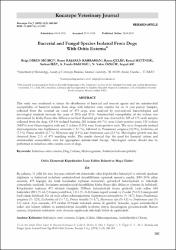| dc.contributor.author | DİREN SIĞIRCI, Belgi; BAŞARAN KAHRAMAN, Beren; ÇELİK, Baran; METİNER, Kemal; İKİZ, Serkan; BAĞCIGİL, A. Funda; ÖZGÜR, N. Yakut; AK, Seyyal | |
| dc.date.accessioned | 2019-02-04T07:28:36Z | |
| dc.date.available | 2019-02-04T07:28:36Z | |
| dc.date.issued | 2018 | |
| dc.identifier.citation | DİREN SIĞIRCI, B , BAŞARAN KAHRAMAN, B , ÇELİK, B , METİNER, K , İKİZ, S , BAĞCIGİL, A , ÖZGÜR, N , AK, S . (2018). Bacterial and Fungal Species Isolated From Dogs With Otitis Externa. Kocatepe Veterinary Journal , 11 (3) , 260-265 . DOI: 10.30607/kvj.412393 | en_US |
| dc.identifier.uri | http://dergipark.gov.tr/download/article-file/541597 | |
| dc.identifier.uri | http://hdl.handle.net/11630/5315 | |
| dc.description | This study was conducted to detect the distribution of bacterial and mycotic agents and the antimicrobial susceptibility of bacterial isolates from dogs with infective otitis externa for an 11-year period. Samples, collected from the external ear canal of 475 dogs, were analysed by conventional bacteriological and mycological methods between the years of 2005 and 2016. Antimicrobial susceptibility of the isolates was determined by Kirby-Bauer disc diffusion method. Bacterial growth was observed in 328 of 475 swab samples collected from the dogs. Of 434 isolated bacteria, 281 isolates (64.7%) were Gram-positive cocci, 151 isolates (34.8%) were Gram-negative rods and 2 isolates (0.5%) were Gram-positive rods. The most frequently isolated microorganisms was Staphylococcus intermedius (18.7 %), followed by Pseudomonas aeruginosa (12.9%), Escherichia coli (7.1%) Proteus mirabilis (6.7 %) Micrococcus spp (4.1%) and Streptococcus canis (2.5 %). Mycological growth was also observed from 213 of 475 matching swabs. The results showed that the need for bacterial culture and antimicrobial susceptibility tests for appropriate antimicrobial therapy. Mycological culture should also be performed in infectious otitis externa cases of dogs. | en_US |
| dc.description.abstract | Bu çalışma, 11 yıllık bir süre boyunca infektif otit eksternaları olan köpeklerden bakteriyel ve mikotik ajanların dağılımını ve bakteriyel izolatların antimikrobiyal duyarlılıklarını saptamak amacıyla yapıldı. 2005-2016 yılları arasında, 475 köpeğin dış kulak kanalından toplanan numuneler, geleneksel bakteriyolojik ve mikolojik yöntemlerle incelendi. İzolatların antimikrobiyal duyarlılıkları Kirby-Bauer disk difüzyon yöntemi ile belirlendi. Köpeklerden toplanan 475 sürüntü örneğinin 328'inde bakteriyolojik üreme gözlendi. İzole edilen 434 bakteriden 281’i (% 64.7) Gram pozitif kok, 151’i (% 34.8) Gram negatif çomak ve 2 izolat (%0.5) Gram pozitif basil olarak belirlendi. En sık izole edilen mikroorganizma Staphylococcus intermedius’tu (% 18.7), bunu Pseudomonas aeruginosa (% 12.9), Escherichia coli (% 7.1), Proteus mirabilis (% 6.7), Micrococcus spp (% 4.1) ve Streptococcus canis (% 2.5) izledi. Aynı zamanda, 475 swabın 213'ünde mikolojik üreme de görüldü. Sonuçlar, uygun antimikrobiyal tedavi için bakteri kültürü ve antimikrobiyal duyarlılık testlerine ihtiyaç duyulduğunu göstermektedir. Bunun yanısıra, köpeklerin enfeksiyöz otitis eksterna olgularında mikolojik kültür de yapılmalıdır. | en_US |
| dc.language.iso | eng | en_US |
| dc.identifier.doi | 10.30607/kvj.412393 | en_US |
| dc.rights | info:eu-repo/semantics/openAccess | en_US |
| dc.subject | Antimikrobiyal Direnç | |
| dc.subject | İnfeksiyöz Otitis Eksterna | |
| dc.subject | Köpek | |
| dc.subject | Mikroorganizma | |
| dc.title | Otitis Eksternalı Köpeklerden İzole Edilen Bakteri ve Maya Türleri | en_US |
| dc.title.alternative | Bacterial and Fungal Species Isolated From Dogs With Otitis Externa | en_US |
| dc.type | article | en_US |
| dc.relation.journal | Kocatepe Veteriner Dergisi | en_US |
| dc.department | Afyon Kocatepe Üniversitesi | en_US |
| dc.identifier.volume | 11 | en_US |
| dc.identifier.startpage | 260 | en_US |
| dc.identifier.endpage | 265 | en_US |
| dc.identifier.issue | 3 | en_US |
| dc.relation.publicationcategory | Makale - Ulusal Hakemli Dergi - Kurum Yayını | en_US |



















